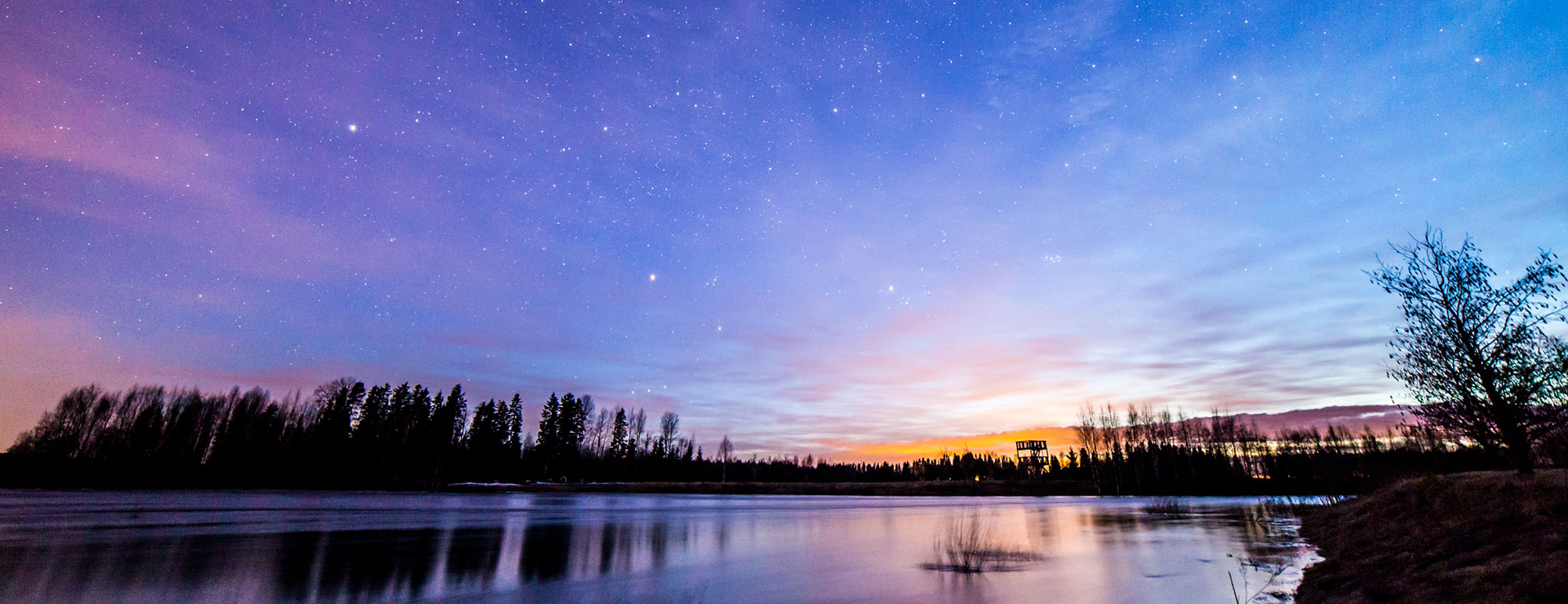Then carry this rule with you in all your contemplations of the universe—as you walk beneath the dome of heaven, as you tremble in the shadows of the everlasting hills, as you rise into rapture while gazing on the swelling grandeur of the great deep and feel yourself wrapt in the presence of God. The universe is the thought of God made visible.
~ R. Venting
Welcome to part 2 of my Psalm 19 series! The stage has been set and we are ready to discuss some of the messages that the author, King David of Israel, has proclaimed in the first six verses. These verses focus on the revelation of God through creation.
19:1. The heavens declare the glory of God, and the sky above proclaims his handiwork.
All creation points to its Creator. The “heavens” here refer to the celestial bodies that occupy the cosmos outside of Earth’s atmosphere – what we refer to as “space” (Hebrew: shâmayim or shâmeh). The “sky” refers to the visible arc of atmosphere that we perceive on a day-to-day basis (Hebrew: râqı̂ya‛). David’s claim in verse 1 affirms the existence of a divine Creator – that by simply looking upwards and seeing the sun, the sky, the moon, the stars, and the clouds, every person who beholds these wonders is a witness to the presence and power of God. In the daily devotional New Morning Mercies, author Paul David Tripp mentions creation as being a “road sign” to God. He states, “…a sign points you to a thing, but the sign is not the thing. Creation points us to the Creator, but it can never give us what the Creator can give” (Devotional for November 5). To observe the natural world, with all its beauty and complexity, without desiring to know and understand the Creator makes as much sense as being so enraptured by the Mona Lisa that you would rather gaze at the painting than sit down and have tea with the creator of the masterful art piece. Just as the Mona Lisa showcases the talent and craftsmanship of DaVinci, creation stands witness for the attributes of Almighty-God, the Creator, Sustainer, and Redeemer of the earth.
19:2. Day to day pours out speech, and night to night reveals knowledge.
Through the constant repetition of day to night to day to night, the glory, wisdom, power, and faithfulness of God are continually revealed. The consistency with which God preserves the patterns of day and night harken back to His covenant with Noah in Genesis 8:22. There, God promises that “while the earth remains, seedtime and harvest, cold and heat, summer and winter, day and night, shall not cease” (emphasis mine). We can trust God to keep this promise because he is the One who established the concepts of light and darkness, day and night, at the very beginning of the world when He “separated the light from the darkness” (Gen. 1:3). In Isaiah 45 we again see this day-night motif when God declares His presence, power and faithfulness are revealed “from the rising of the sun and from the west” (45:6) so that when people see the sun they will “know…there is none besides [the Lord]” (45:6) for it is He who “form[s] light and create[s] darkness” (45:7). As in Psalm 19:1-2, Isaiah is connecting the rising sun and the contrast between light and dark to a proclamation of God’s existence and infinite wisdom.
19:3-4a. There is no speech, nor are there words, whose voice is not heard. Their voice goes out through all the earth, and their words to the end of the world.
As we saw in the first two verses, these phrases are reiterating the voice of creation as it “declares” and “proclaims” God’s glory. But what is the “voice” that David is referring to? The sun does not have language. The clouds do not give an audible shout as they drift by overhead. We do not walk through a forest and hear the trees suddenly burst into song. Rather, their “speech” is embedded in their very nature. The heavens declare God’s glory by simply doing what it was made to do – by providing light to mark the days and the seasons (Gen. 1:14-18). The earth shouts praises to its maker by fulfilling its calling to bring forth vegetation, to flower and grow and provide food for other living organisms (Gen. 1:11-12). The language of nature is therefore a universal language, which is why Paul, in Romans, states that all men are “without excuse” for denying the power and existence of God, because it has been “clearly perceived…in the things that were made” (1:20).
19:4b-5. In them he has set a tent for the sun, which comes out like a bridegroom leaving his chamber, and, like a strong man, runs its course with joy.
As a continuation of verses 3-4a, David is here providing more intimate detail in how the heavens are declaring God’s glory – specifically with the entity of the sun. Why would he choose the sun? Many biblical scholars think it’s highly probable that David wrote this Psalm while watching a sunrise. Upon seeing the radiance of colors splashed across the morning sky, David saw the “glory of God” displayed, laid out for all the world to see. Another notable parallel is the physical entity of the sun symbolizes the coming Son of God, which I will discuss in more detail later. There is no small amount of symbolic imagery within these verses, but for the sake of time I will only focus on two: the place and the joy of the Sun. Before examining these concepts, however, it’s necessary for me to add a caveat regarding the following discussion: I struggle to completely understand the many messages and foreshadows that David is communicating with his symbols. What is written below is my interpretation that I developed from reading scholars’ commentaries, discussing the text with David, and uncovering similar uses of key words and phrases from Psalm 19:4b-5 found elsewhere in the Bible. If you have any illuminating insights into this text, I encourage you to share those in the comment section below. I would love to hear your thoughts!
- The place. David says God has appointed a “tent,” or in some translations a “tabernacle,” for the sun. In the Old Testament, the Tabernacle, also called the Tent of Meeting, was a portable dwelling place of God where His presence would settle among His chosen people (see Exo. 26-27:19). The Old Testament Tabernacle was a symbol of the coming Messiah, Jesus Christ, the Son of God and the Sun of Righteousness, with whom the Father eternally dwells as “one” (John 10:30). After Jesus ascended into Heaven and was “highly exalted” (Php. 2:12) and enthroned at the right hand of the Father (Mark 16:19, Eph. 1:20-21) he was established in his rightful place. Just as the Father “set a tent for the sun” – its rightful place in the sky from which it gives light, heat, food, and ultimately life to the earth – Jesus Christ is now sitting enthroned beside his Father with “all things under his feet” (Eph. 1:22) and it is through the “name of Jesus” (Php. 2:12) that we are given eternal life (John 3:16, Acts 16:31). He is the Son who, by the will of the Father and through the work of the Spirit, provides us with all our needs.
- The joy. The sun is compared to a “bridegroom leaving his chamber”. How would a bridegroom, who is going to claim his bride, look and act? His clothes would be lavishly adorned (Isa. 61:10), and his demeanor would radiate joy and excitement, affecting all his friends and family with the same ecstatic anticipation (John 3:29). Jesus Christ is also likened to a bridegroom, coming soon to claim us, his bride, the Church, and is not doing so with reluctant acceptance but with ecstatic anticipation: “…and as the bridegroom rejoices over the bride, so shall your God rejoice over you” (Isa. 62:5). In Revelation, the marriage imagery continues by comparing the “new Jerusalem” with “a bride adorned for her husband” (Rev. 21:2). Both the bridegroom and the bride are anticipating the moment when she will become his and he will go to claim her, and if you’ve ever been married (which, I have not, so I can only use my imagination here) you know the overwhelming joy of being united in marriage! But even that is a dusty image of the eternal joy we will experience when Christ, our long-awaited Bridegroom, comes to claim us as His Bride.
In Psalm 19, David does not stop the marriage imagery there, however. He goes on to say the sun “run its course with joy”. It does not become tired of the same monotonous motion of going round and round the earth[1], but rather joyfully completes its continuous cycle, just as Jesus, the Son of Righteousness, “for the joy that was set before him endured the cross” (Heb. 12:2), faithfully completed his work on Earth. Without the person and work of Jesus, we would have no hope of joining the marriage feast in Eternity. Furthermore, the Bridegroom knows, adores, and cares for his Bride ‘all-around’ – he knows her more intimately than anyone and finds a satisfaction in her that is unmatched by anything in creation. The joy that the Groom receives from gazing on his bride does not diminish, but rather is renewed every day. Likewise, the sun “gazes” on the earth, providing warmth, light, and food (literally, by driving photosynthesis) for the “green pastures” (Psa. 23:2) as it completes its course with joy and anticipation every day.
19:6. Its rising is from the end of the heavens, and its circuit to the end of them, and there is nothing hidden from its heat.
This final statement is a bookend with verse 1 to the first stanza of Psalm 19. It declares the universality of the sun’s influence. Just as the “heavens declare the glory of God” (v. 1) loudly enough to leave all men “without excuse” (Rom. 1:20), so the heat of the sun touches everything in its path. This path extends throughout the universe – from one end of the heavens to the other – which means nothing in the entire universe can escape. Again, the physical sun points symbolically to Jesus, the eternal Son, in whom everything was made (John 1:1-4) and from whom nothing can hide (Psa. 139).
To close, I will leave you with these words from Matthew Henry’s commentary on Psalm 19:1-6:
From the excellency of the work we may easily infer the infinite perfection of its great author. From the brightness of the heavens we may collect that the creator is light; their vastness of extent bespeaks his immensity; their height his transcendency and sovereignty, their influence upon this earth his dominion, and providence, and universal beneficence: and all declare his almighty power, by which they were at first made, and continue to this day according to the ordinances that were then settled.
Stay tuned for my next post where we will continue this verse-by-verse discussion of the second half of Psalm 19.
*All scripture references used in this post were taken from the ESV translation unless otherwise noted.
[1] This statement is made purely assuming a human’s perspective from Earth, watching the sun as it rises and sets. I do not intend to assert a geocentric worldview.

